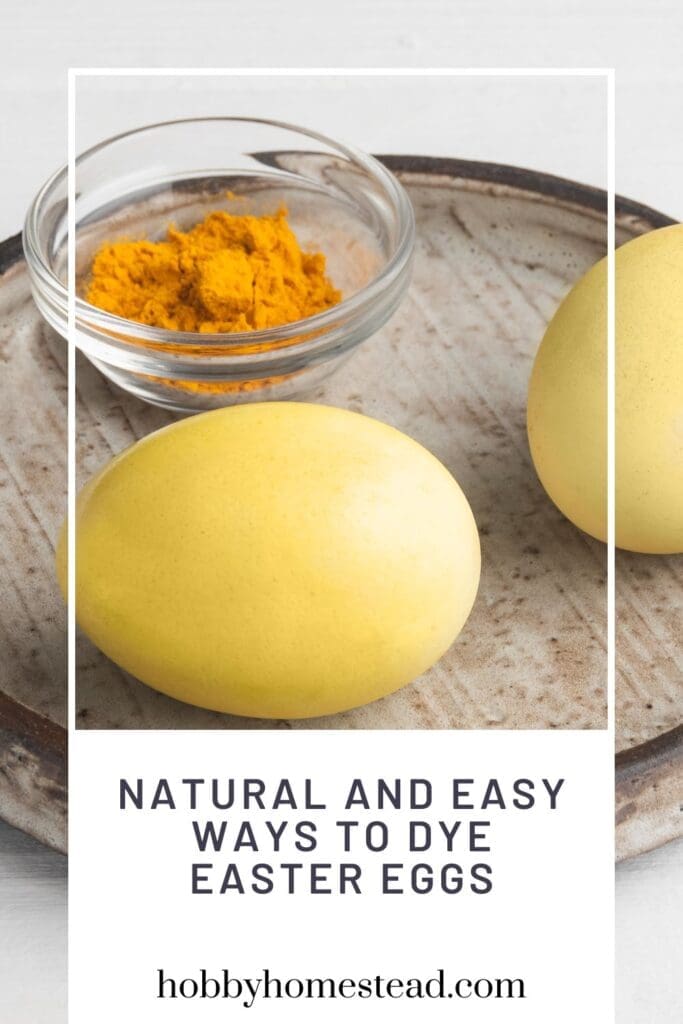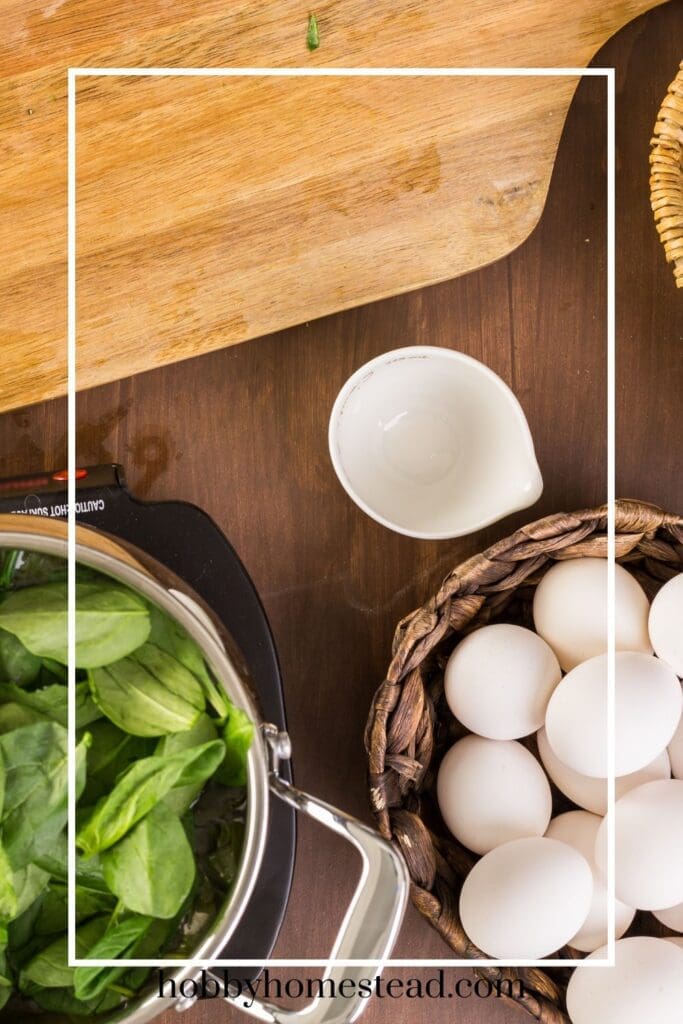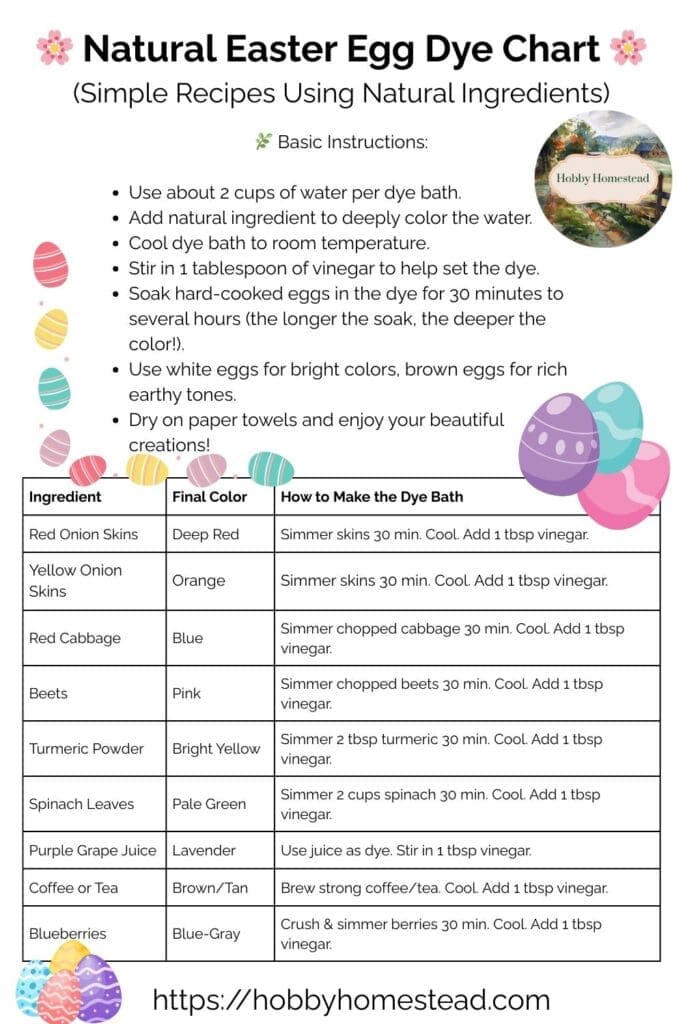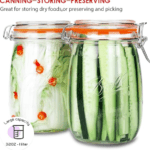Make beautiful colors with natural and easy ways to dye Easter eggs. One of my favorite parts of the Easter tradition is gathering around the kitchen table with the whole family to dye Easter eggs. While the store-bought kits are convenient, there’s something extra special (and fun!) about using natural ingredients right from your pantry, vegetable scraps, or backyard to create beautiful, earthy colors.
After reading an article on using natural ingredients for dyeing eggs, we thought we’d give it a try. It’s amazing how simple it is to use what you already have at home to create gorgeous works of art!
If you’re looking for a more sustainable, chemical-free approach this year, I’m excited to share some natural and easy ways to dye Easter eggs that fit perfectly into a homesteading lifestyle.

It just takes a few easy steps to create beautiful and colorful eggs. We’re sharing what we found out. We even have some suggestions on colors you’ll get depending on what you are using to naturally add color.
Why Choose Natural Dyes?
Using natural dyes for your hard-boiled eggs is not only safer and eco-friendly, but it also connects you with a time-honored tradition that goes back generations. Plus, you likely already have most of what you need at home — no need for extra trips to the grocery store! And, you can make just a few or a lot of eggs for decorating, eating, and memorable Easter egg hunts.
Natural dyes can create gorgeous, subtle shades you won’t find with artificial colors. From soft blues and yellows to rich rusts and greens — perfect for filling Easter baskets with one-of-a-kind, colorful eggs.
Natural Ingredients You Can Use
Here are some of the best natural items to create your own dye bath:
| Natural Ingredient | Color on White Eggs | Color on Brown Eggs |
| Red onion skins | Deep maroon | Burnished gold |
| Yellow onion skins | Orange to warm yellow | Soft caramel |
| Red cabbage | Blue to teal | Smoky blue-gray |
| Beets | Pink to red | Earthy rose |
| Turmeric powder | Bright yellow | Mustard yellow |
| Spinach leaves | Pale green | Olive green |
| Coffee or black tea | Brown to tan | Rich mahogany |
| Purple grape juice | Lavender | Dusty purple |
How to Dye Easter Eggs Naturally: Step-by-Step
1. Gather Your Supplies
- Hard-boiled eggs (white or brown eggs — brown gives richer, deeper tones!)
- Natural dye materials (onion skins, red cabbage, beets, etc.)
- White vinegar or lemon juice
- Large pots for boiling
- Paper towels for drying
- Spoons and tongs
- Mason jars or cups for soaking
2. Make the Natural Dye Bath
- Place about 2 cups of chopped vegetable scraps or natural ingredients into a saucepan.
- Add 2 cups of water and bring it to a boil.
- Lower heat and simmer for 20–30 minutes, or until the color is rich.
- Strain out solids, reserving the liquid.
- Stir in 1 tablespoon vinegar per cup of dye to help the color set.
3. Dye Your Eggs
- Place cooled, hard-boiled eggs into the dye bath.
- Soak them for at least 30 minutes, or up to several hours for deeper shades.
- Gently remove eggs with a spoon and let them dry on a rack or paper towels.
Tip: The longer the eggs soak, the more vibrant the color!

5 Extra Tips for Naturally Dyed Eggs
- Use room temperature eggs for the best dye absorption.
- Wrap eggs in cheesecloth or rubber bands before dyeing for fun patterns.
- Experiment with layering colors by dyeing an egg in one color, then dipping it in another.
- Polish with olive oil once dry to give your eggs a beautiful, glossy finish.
- Try brown eggs for muted, vintage-style tones that are just stunning.
Natural Dyeing Variations to Try
- Marbled Eggs: Crack the shell of a hard-boiled egg slightly before dyeing for cool marble-like patterns.
- Speckled Eggs: After dyeing, lightly flick a toothbrush dipped in a darker natural dye over the eggs for a speckled effect.
- Two-Tone Eggs: Dip only half the egg into a second color for an artistic look perfect for your Easter celebration.

Can you eat naturally dyed eggs?
Yes! As long as your hard-boiled eggs were properly refrigerated and handled safely, they are perfectly fine to eat after dyeing.
What’s the best way to hard boil eggs for dyeing?
Place your regular eggs in a pot, cover with cold water, bring to a gentle boil, then simmer for 10 minutes. Cool quickly in cold water to avoid gray yolks.
How long do naturally dyed eggs last?
Just like regular hard-cooked eggs, naturally dyed eggs should be stored in an airtight container in the refrigerator and enjoyed within a week.
What if I don’t have fresh vegetables?
Dried ingredients like onion skins or spices like turmeric and paprika work beautifully too. Great for using up pantry odds and ends and adding different colors.
Can I dye eggs with vegetable scraps I would normally compost?
Absolutely! Onion skins, beet peels, and cabbage leaves are a great way to give your kitchen scraps a second life before they head to the compost bin.
Celebrate Easter the Natural Way
Whether you’re using onion skins, lemon juice, or colorful vegetable scraps, natural egg dyeing is a beautiful way to embrace spring and create lasting memories with your family. Plus, it’s a wonderful example of how the simple things — the scraps, the patience, the care — can make the most beautiful traditions.
This year, why not skip the store-bought kits and celebrate with your very own, homemade natural dyes? You’ll be amazed at the colors you can create with just a little bit of nature and love.
Happy Easter and happy dyeing!
Natural and Easy Ways to Dye Easter Eggs
As an Amazon Associate I earn from qualifying purchases.
Materials
- Hard-boiled eggs white or brown eggs — brown gives richer, deeper tones!
- Natural dye materials onion skins, red cabbage, beets, etc.
- White vinegar or lemon juice
Instructions
Make the Natural Dye Bath
- Place about 2 cups of chopped vegetable scraps or natural ingredients into a saucepan.Natural dye materials
- Add 2 cups of water and bring it to a boil.
- Lower heat and simmer for 20–30 minutes, or until the color is rich.
- Strain out solids, reserving the liquid.
- Stir in 1 tablespoon vinegar per cup of dye to help the color set.White vinegar or lemon juice
Dye Your Eggs
- Place cooled, hard-boiled eggs into the dye bath.Hard-boiled eggs
- Soak them for at least 30 minutes, or up to several hours for deeper shades.
- Gently remove eggs with a spoon and let them dry on a rack or paper towels.
- Tip: The longer the eggs soak, the more vibrant the color!
Notes

Reference
Serious Eats. These Everyday Ingredients Are the Best Natural Dyes for Easter Eggs.








Thanks for this information.